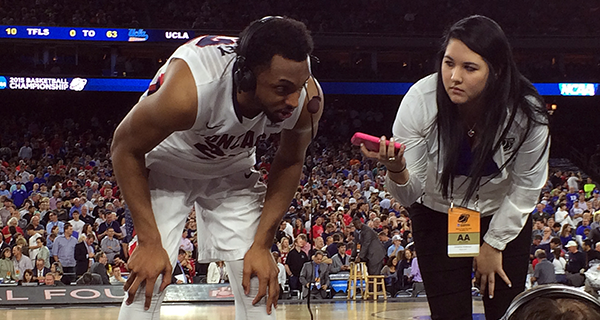By Peter Tormey, Gonzaga News Service Editor
With Gonzaga’s remarkable streak of 17 consecutive trips to the men’s NCAA basketball tournament – and the women’s seventh-straight Big Dance – it may be hard for some to imagine life before March Madness. In my seventh of now 23 years writing for Gonzaga, I was fortunate to have witnessed Casey Calvary’s famous tip-in of Quentin Hall’s shot to beat Florida in Phoenix in 1999 – Gonzaga’s coming-out party as a rising power.
I remember we had nearly a million hits to our website as people sought to discover – as Los Angeles Times columnist Chris Erskine wrote – “What’s a Gonzaga?” One pundit posited Gonzaga was a monster, like Godzilla, perhaps?
I recall the 1999 media feeding frenzy – a carnival-like atmosphere, really – as news trucks parked on campus and reported live each day while the Zags kept dancing. Our switchboard was besieged with calls from people wanting to know our namesake. “It’s St. Aloysius Gonzaga, the 16th century Italian Jesuit saint and patron of youth,” we said.
Since then, I’ve followed the Zags to NCAA Tournaments each of the past nine years – writing, blogging, doing video interviews and watching games from courtside. Behind the scenes, the NCAA treats media well with scheduled (yet limited) access to the student-athletes and coaches, a few meals, Internet access and other accommodations.
‘No Secret Fraternity Hand Signals’
As communication has become real-time, some trivial yet amusing things have occurred. Before our March 20 game at Seattle’s KeyArena vs. North Dakota State, a network employee informed me I’d be behind the game’s TNT announcers Spero Dedes, Mike Gminski and Jaime Maggio – saying “no secret fraternity hand signals” allowed.
I thought nothing of it until I received a text, a moment before tipoff, from my wife. “Hey Hon, just saw you on TV. You look good!” Moments later, Gonzaga broadcasting Instructor Dan Garrity tweets, “I just hope we get to see Pete Tormey on tv again!” Returning home, many friends and colleagues also reported seeing me on TV.
Behind the scenes in Houston, it was fun getting to know some of the major daily newspaper writers and discuss issues such as possible reasons for the poor shooting performances by teams in the NRG Stadium, an enormous football arena that’s home to the NFL’s Houston Texans. Before the Duke game on March 29 in NRG, I witnessed a parade of celebrities courtside, including Dallas Cowboys’ quarterback Tony Romo, who played for Eastern Illinois University but is a big Blue Devils’ fan.
Waiting for the Duke game to begin, I met Zag accounting major Michael Bokan, from Boise, Idaho, wearing a Gonzaga jersey and his brother Ryan wearing a Duke shirt. Michael was planning to grab a 5:30 a.m. flight the next day to make it back to campus for his class. That chat resulted in this tweet.
Listening to Coach Mark Few at the press conference before the Duke game, it struck me how far Gonzaga’s program has come since this run began. Few said both Duke and Gonzaga had gotten to the regional final through “sustained excellence throughout this entire season” and not by merely getting hot at the end of the season.
Ironically, Gonzaga in 1999 was that team that got hot in the tournament.
Few knew the Zags would have to play their best to beat Duke and advance to their first Final Four. While they lost to the eventual national champion Blue Devils, Gonzaga posted its best season ever with its most wins (35-3). Few has led Gonzaga to 16 straight NCAA Tournaments and sports the NCAA’s all-time best winning percentage among active coaches.
Clearly, Gonzaga basketball has become a model of sustained excellence. The University, to its credit, has leveraged this success to help significantly grow enrollment, facilities, fundraising, and its academic profile – putting Gonzaga in a strong position to withstand the turbulence of increasing headwinds in higher education.
The goodwill Gonzaga has accrued through the generations of people it has educated continues to assure its well-being.
As Father James Rebmann, S.J., Gonzaga’s first and sixth president, noted more than a century ago:
“Bright then, though our future be, it cannot be more bright than we wish it.”
- Subscribe to the Gonzaga News Service twitter feed @GonzagaUNews
